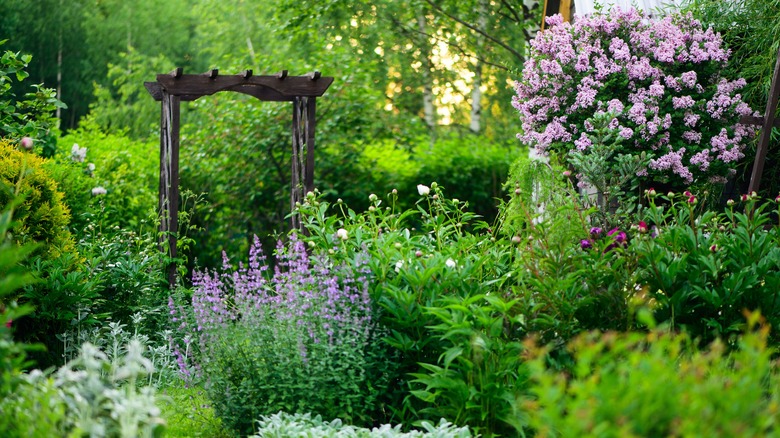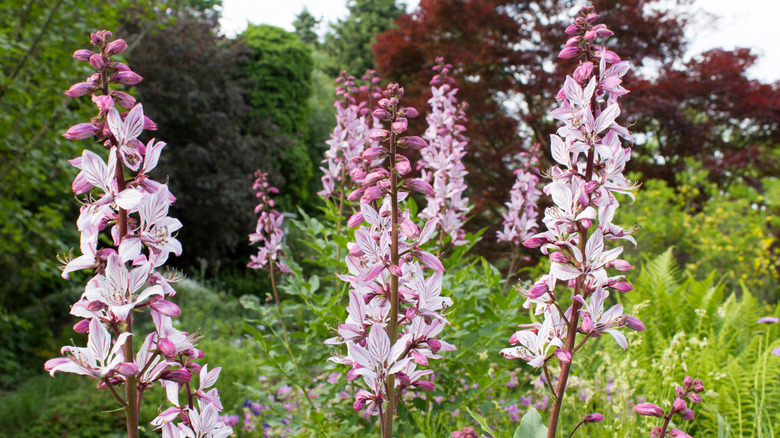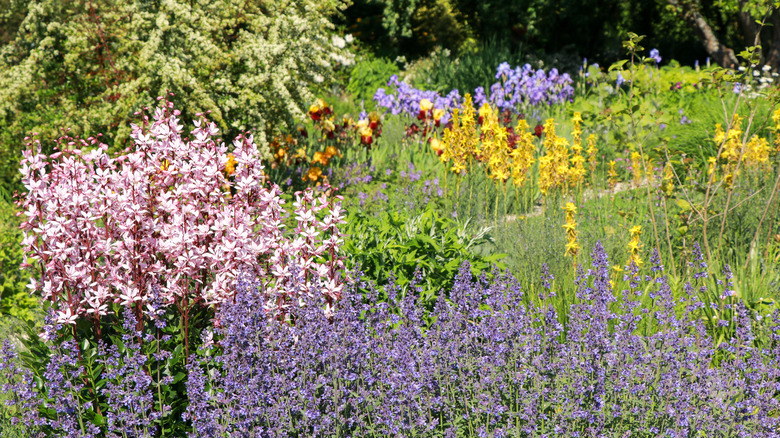The Underrated Perennial That Gives Your Garden A Cottage Core Vibe
The charm of a cottage core garden lies in its abundance of blooms in different pastel hues, where more truly is more. But some plants, such as the gas plant (Dictamnus albus), naturally capture the romantic aesthetic in this type of garden better than others. This white, purple, or pale pink perennial has an upright, bushy shape with glossy green foliage that brings an air of vintage elegance to your green space. Its shape, structure, and powdery hues make it perfect for crafting a layered, cottage garden look.
Despite its old-world charm and pretty blooms, it remains surprisingly underused in most gardens. Mark Dwyer, former director of horticulture at Rotary Botanical Gardens in Wisconsin, even told Nursery Management that the "gas plant is one of the most underappreciated and underutilized perennials in our gardens." One reason it flies under the radar? It's a slow starter, often taking two to four years to finally bloom, which might turn off gardeners looking for quick results. But once it settles in, this perennial becomes a standout. Growing up to 3 feet tall, it adds height and structure, and pairs beautifully with favorites like lavender (Lavandula x intermedia), catmint (Nepeta x faassenii), and foxgloves (Digitalis purpurea), which are perfect for an English cottage garden.
How and where to grow the gas plant
The gas plant is a fairly hardy perennial, thriving in USDA Zones 3 through 9, making it a great choice for a wide range of climates. As a bonus, this fragrant perennial flower will make your garden smell amazing all summer long. While it can live for decades once established, it does require some patience when it's first planted, so don't be discouraged if no blooms appear on it for the first few years. To plant the Dictamnus albus, choose a spot in full sun, or with some dappled shade, and well-drained soil. Just be sure you're happy with the location before planting, as gas plants don't like to be moved after they've settled in.
Once established, the gas plant is an easy-going, low-maintenance perennial that's both drought-tolerant and naturally resistant to common garden pests. That's thanks to the strong-scented oils in its leaves and stems, which act as a natural deterrent. However, those same oils can be irritating to humans and some people may develop a rash after handling the plant. Plus, they're considered toxic if ingested, so it's best to plant it in spots out of the way of curious pets and children. It's also worthwhile noting that the spent flowers and seed pods emit an oil on hot days, which is flammable. This can easily be ignited with a match, hence the common name "gas plant."
In early summer, the gas plant produces delicate, spiky blooms that attract a variety of pollinators, including butterflies. While it's not invasive or aggressive, mature plants can spread up to 2 feet wide, so be sure to give them enough room to grow in your yard.
Incorporating the gas plant into your cottage core garden
The beauty of a cottage core garden is that anything goes. But if you want to design and plant the perfect cottage garden, there are still a few things to keep in mind when deciding where to place your gas plant. As its flowers are spiky, you might want to soften their look by surrounding them with more delicate cottage garden flowers such as peonies (Paeonia spp.), irises, or lamb's ear (Stachys byzantina). This contrast helps balance the structure of the gas plant and adds to the layered, slightly overplanted charm that cottage gardens are known for. Its upright shape and height make it a great mid-to-back border plant, where it can add structure without overwhelming the softer, sprawling flowers around it.
To create that lush, cottage core-style, try pairing gas plants with low-growing companions like hosta, catmint, and lavender. Taller bloomers like foxgloves, hollyhocks (Alcea rosea), or delphiniums (Delphinium elatum) add vertical interest behind it, while the gas plant's strong stems hold their own. The result is a relaxed but thoughtfully arranged garden that feels full, romantic, and a little wild, just as a cottage garden should.


